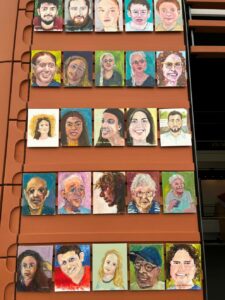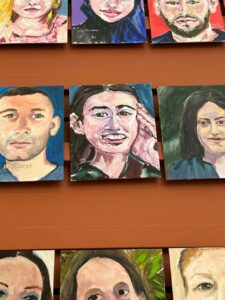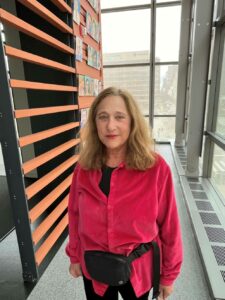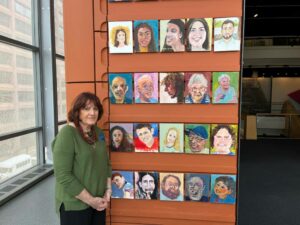
More than 200 people were taken hostage by Hamas on Oct. 7.
Their faces are now on the walls at the Weitzman National Museum of American Jewish History in Philadelphia.
A third-floor exhibit shows their faces in painted color. There’s the smiling woman with lighter skin and brown glasses. There’s the half-smiling man with deep-set eyes and a receding hairline. There’s a younger man with close-cut hair and a focused look on his face.
Eight local artists painted those faces from the widely distributed pictures of the hostages, according to the Weitzman. They were led by Sivia Katz Braunstein, a Center City-based artist who was in Israel on Oct. 7. The group also included Nancy Gordon, Deborah Morris Zakheim, Judy Rohtbart, Jane Bennett, Carol Lert, Sue Seif and Carol Sack Denmark.
The exhibit went up on March 8 and will run through April 14.
“I have a close relationship with Israel,” Braunstein said. “I’m there once a year.”
The artist was visiting her sister and her sister’s family on Oct. 7. Her sister lives on Kibbutz Gezer in central Israel. The night before, the family ate pizza in the sukkah for Sukkot. “There was singing. And the kids were making flags,” Braunstein recalled. “And then we had dinner and went to sleep.”
The next morning, Braunstein’s sister woke everyone at 6 a.m.
“Get dressed…now,” she said, according to Braunstein.

As the sirens went off, the family walked across the kibbutz to Braunstein’s niece’s house. The new houses need to have safe rooms. The family stayed there for two days.
“We didn’t really know what was going on,” Braunstein said.
Then, Braunstein’s brother-in-law drove her and her husband back to their hotel. There were concrete steps that went down six floors, according to Braunstein. They went down with about 80 other hotel guests.
“Anytime the alarm went off,” she said. “That’s what we did.”
It was a week before they were able to get out. They flew to Europe because they couldn’t get a flight back to the United States. From Europe, they finally found a flight back.
“The airport in Tel Aviv had many people just waiting,” Braunstein said.
“I knew that I had to do something. But I didn’t know what,” she added.
Then the photos of the hostages came out from the hostage families.
“And I just got some boards and started painting them,” Braunstein said.

As she spoke, Braunstein looked at the faces on the wall. She was asked to point one out. She pointed to “Dietza…Hayman.”
Hayman is an older woman with short white hair, a smile on her face and a coffee mug in her hand.
“I saw her picture with the coffee,” Braunstein said. “And I just imagined her having taught generations.”
“Grandchildren and waiting for everybody to come to her house to cook for them,” the artist continued. “It just looked like she was sitting in front of the house.”
Braunstein was asked to point out another. She pointed to Louis Har. He’s a smiling older man with glasses and a blue hat.
“He just had a face and a smile that was just so warm,” the artist said. “He’s just saying that he loves life.”

“I really hope that people see this could have been your neighbor. This could have been your friend. This could have been your sister or brother,” Braunstein concluded.
Deborah Morris Zakheim was standing nearby as Braunstein spoke. She was also looking up at the faces she helped paint.
When asked to point one of her paintings out, the resident of Philadelphia’s Bella Vista neighborhood pointed to a smiling young woman with dark features. Her name is Noa Argamani.
“She was the one on the motorcycle that you saw immediately from the music festival who was yelling out to her boyfriend who was captive behind her,” Zakheim said. “You’re trying to create them as they were alive.”
“These are all human beings that were living their life,” she continued.
Zakheim believes that Argamani is still alive in captivity.






